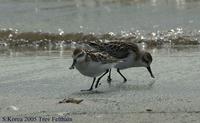Surfbirds News: BirdLife International Archives
Eurynorhynchus pygmeus
, is now worryingly close to becoming extinct. With only 200-300 pairs left, conservationists are calling for urgent help to tackle the decline.
“We’ve seen a 70% drop in the number of breeding pairs at some sites over the last couple of years. If this decline continues, these amazing birds won’t be around for much longer,” says Evgeny Syroechkovskiy, Vice President of the Russian Bird Conservation Union (BirdLife in Russia).
Spoon-billed Sandpiper ?? Trevor Feltham
The reasons for these losses are complex, involving changes to habitat during migration and loss of breeding areas. What is clear is that nest predation by foxes and disturbance by people and dogs could prove to be the final nail in the coffin for the few birds left.
“Action to safeguard the remaining breeding pairs needs to be taken now for there to be any chance of saving them. We are planning to put wardens in place at these critical sites. Once they are protected and the birds are successfully fledging young, we can get on with the task of trying to save areas that they use whilst on migration,” Evgeny adds. |

